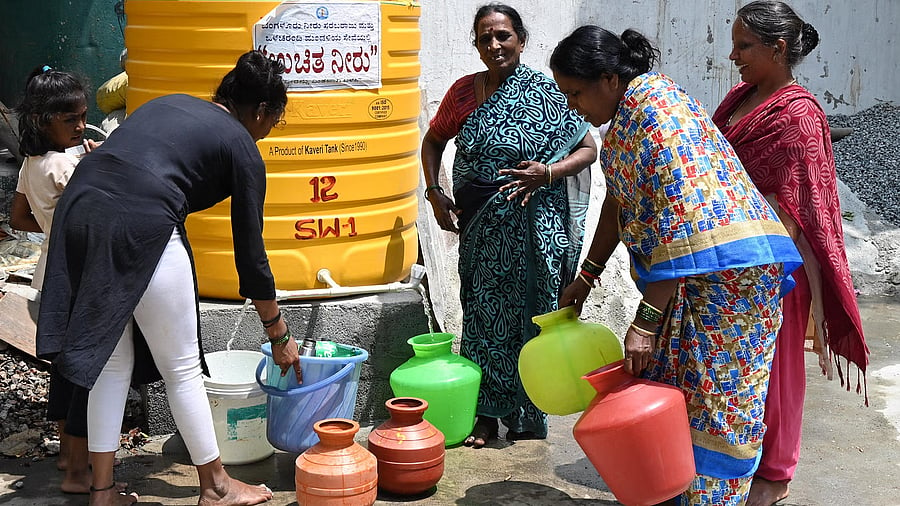
Women fill water amid a water crisis in Bengaluru.
Credit: DH file Photo
Bengaluru: As the heat of summer intensifies over Bengaluru, many citizens have started fearing the circumstances of last year when falling groundwater levels and a struggling private water transportation network failed to meet the city’s burgeoning water demand.
A recent study by the Indian Institute of Science supports these anxieties, predicting that 80 wards out of 200 have a heightened risk of water shortages due to falling groundwater levels.
“All work in the house had come to a standstill. We did not have water for 2-3 days at a time because tankers would keep pushing the time and dates of arrival. We had to stay with relatives since we could not even get ready for the office,” says Prerana, a resident of Whitefield. This year, she worries that another water crisis is around the corner.
Wards on the borders of Bengaluru, on the south-east of Bengaluru and around Whitefield face the highest risk due to falling groundwater levels. These areas, as ascertained by the study, rely on communal, personal or public-owned borewells. Villages and areas on the periphery of the city may have already experienced a drop of 20 to 25 metres in groundwater levels compared to other times.
The study underscores the circumstances of a fastly developing periphery of the city and its dependence on groundwater to fulfil water requirements, says Shubha Ramachandram, a water sustainability consultant.
“Many high-rises and newer developments in these areas do not have a piped water supply and may rely on borewells and tankers to meet water needs. When groundwater levels decline, there is an increase in demand for private water supply,” she adds.
The IISc study estimates that around 800 MLD of water is extracted from borewells for use in the city every day. Additionally, a statement in the Assembly by Deputy Chief Minister D K Shivakumar in February last year highlighted that close to 20 per cent of the city was dependent on tanker water supply.
The circumstances
Understanding the facets that contributed to the low accessibility of water in the previous year is key to implementing remedial measures this year. “2023 was a drought year. Additionally, the Varthur and Bellandur lakes were being desilted, due to which percolation activities were interrupted,” says Avinash Krishnamoorthy, co-founder and director of Biome Environmental Solutions, a Bengaluru-based design firm focused on ecology, architecture and water.
Apartments, across Bengaluru opt out of municipal water supply due to a variety of causes, a primary among which is the high upfront cost to be paid to the Bangalore Water Supply and Sewerage Board (BWSSB). The pro-rata charges are Rs 400 per square metre. “This led to many pockets experiencing a more acute crisis than others. There was also an inflation in private tanker water supply due to this regional imbalance,” she says.
Mitigation measures
Identifying these areas and building alternative systems for accessing water is also necessary. To its credit, the BWSSB is in the process of implementing a monitoring mechanism to measure groundwater levels across 3,000 borewells in the city, with the support of IISc. At present, 300 borewells have been fitted with the mechanism.
The Board also plans to launch a ‘web-based mobile adaptive application’ that would lead residents to request tanker water supply through the BBMP. “The tankers would have GPS tracking and water would only be supplied to customers who will provide an OTP. The platform will enable us to account for how much water is being supplied to individuals. The app will be launched by the end of March,” says Ram Prasath Manohar, chairman of the BWSSB.
These stop-gap measures will help meet the city’s water needs in these summer months while long-term projects will provide these areas with piped water connections. For instance, the Cauvery Stage V project aims to provide 3.5 lakh connections. Currently, around 90,000 connections have been provided.
While piped water supply can help alleviate an overreliance on groundwater, it is clear that the connections come in bursts and are not being installed to keep pace with the rate of Bengaluru’s growth. There is a need to increase focus on water recharge and groundwater management to ward off similar crises in the present and the future, says Avinash.
“Several shallow water aquifers like wells are defunct, filled with rubble and these, if utilised, could be good sources of percolation and a way to mitigate floods. Additionally, Jakkur and Sarakki lakes in Bengaluru have been filled with treated wastewater, and this can be a way to stop the drop in groundwater levels, ” says Avinash. These measures can provide for a broader range of resources to remain accessible even as the mercury rises.